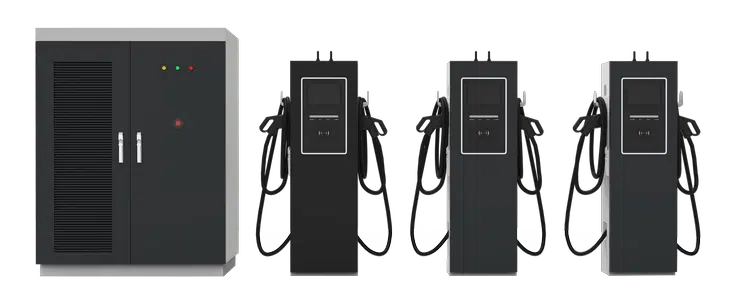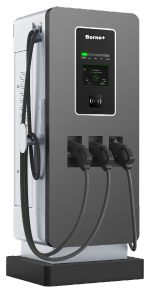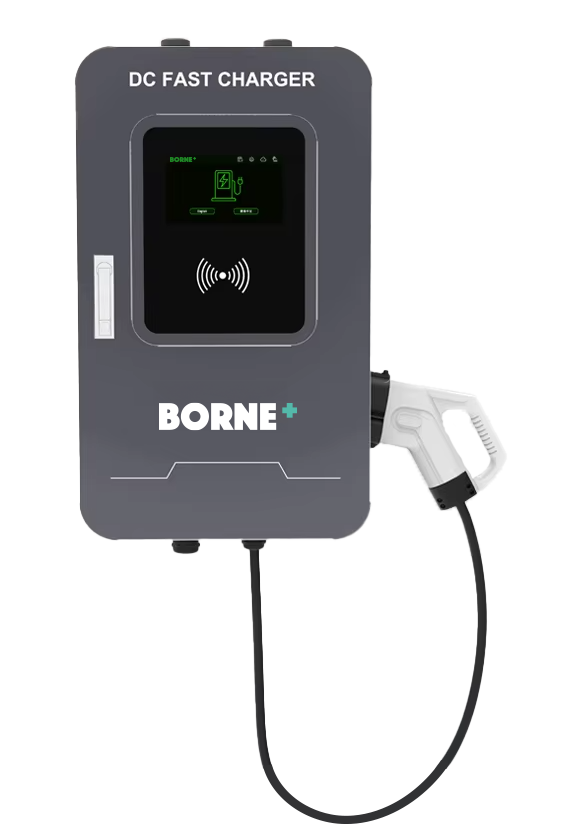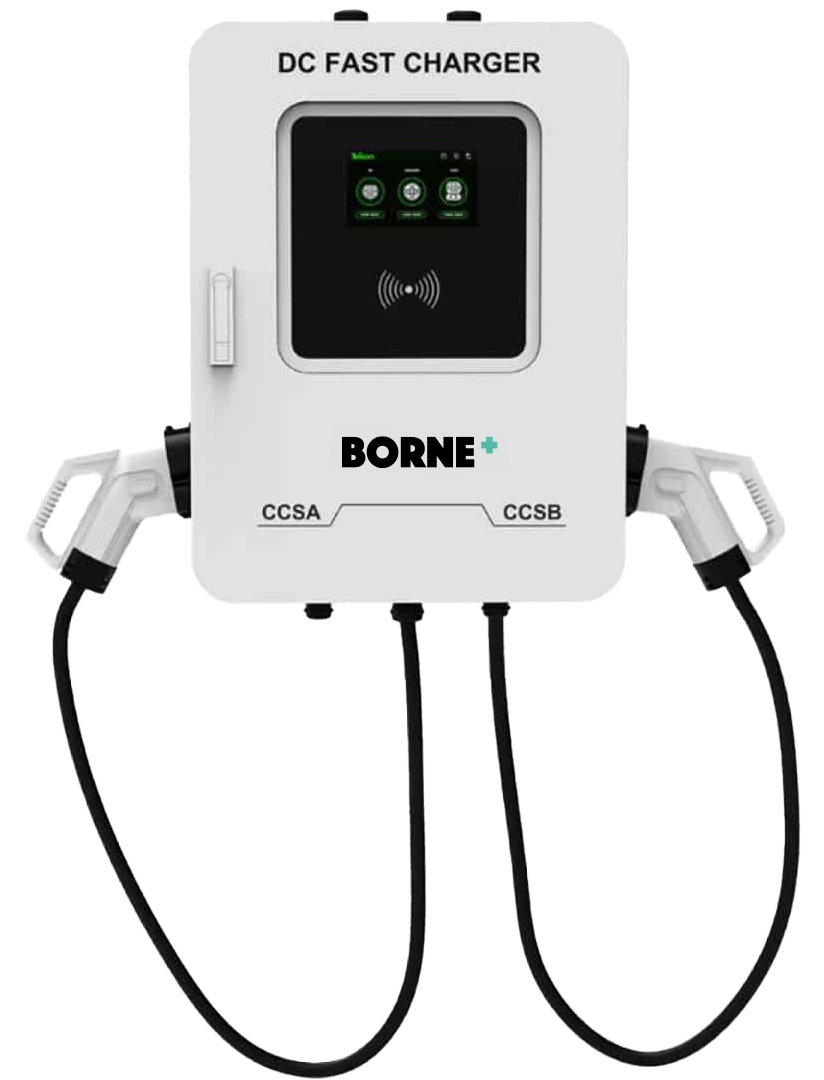DC products
Fast DC terminals up to 960kW, simplified and efficient installation
14 Days to
change your mind

1-year manufacturer’s
manufacturer
Shipping
in 24h
Everything you need to know about DC charging stations
AC/DC comparison, advantages, choice and installation of DC charging stations
What you need to know about the DC charging point
The DC charging point is an ultra-fast charging method. It provides power in excess of 43 kW, enabling electric cars to recover their full range in less than 30 minutes, depending on the power of the charging point and the capacity of the on-board connector. Very few homes are equipped with this type of infrastructure. They are often installed in shopping centre car parks or motorway service areas. To find out more about how this type of equipment works, follow the guide.
What are the differences between a DC charging point and an AC charging point?
There are two types of electrical current used for different purposes: alternating current (AC) and direct current (DC). In France, the domestic network produces alternating current. As batteries only store direct current, alternating current is converted using a converter charger to recharge an electrical appliance.
Electric vehicles can be charged in two ways: via AC terminals and DC terminals. AC current is not used in its original form, but converted into DC current. The alternating current, once it arrives in the car via the charging point, is transformed by the vehicle’s internal converter into direct current and then transmitted to the battery to enable it to function.
By using a DC charging point, the car’s internal converter is no longer used, as it is the charging point itself that transforms the AC current into DC current before injecting it into the battery. The charging process begins when the DC charging cable is plugged into the vehicle’s DC charging socket. It then transmits a communication to the car charger to determine the maximum voltage and current that the battery can receive. Once the relevant parameters have been set, the car charger sends a high-voltage direct current to the battery, enabling the car to be recharged quickly. During the recharging process, the DC charger monitors the battery temperature to ensure that recharging runs smoothly.
Conventional charging points can be installed in private homes and public charging points of normal capacity.
What are the advantages of using a DC charging point?
Using a DC charging point offers a whole host of advantages :
Fast charging
A DC charging point is also known as a ‘fast charging station’ because, as mentioned above, it can fully recharge an electric car’s battery in just a few minutes. A traditional charging point can take several hours to fully recharge a battery.
High power
The recharging power of a conventional charging point ranges from 3 to 11 kWh, compared with 50 kWh to 350 kWh for the DC charging point. That’s another reason why DC charging stations can be used for ultra-fast recharging.
Great ease of use
DC charging points are often installed in easily accessible locations such as public parking areas, service stations, shopping centres, etc. What’s more, they optimise the range and flexibility of electric cars, allowing drivers to recharge their batteries easily while on the move.
Optimum adaptability
A DC charging point can be powered either by the electricity grid or by renewable energy sources such as wind or solar power. The latter option significantly reduces greenhouse gas emissions and helps to combat climate change.
How do I choose a DC recharging point?
To ensure that the DC charging point is adapted to the specific charging needs of electric cars, it is important to take a number of parameters into account when choosing it :
Charging power
The charging power generated by the DC station must meet the requirements of the vehicle’s battery. The charging power of fast-charging stations varies from 50 kW to 350 kW or more, depending on the model and brand.
Connectivity
The DC charging point must be compatible with the electric car’s DC charging socket. Most clean car models use CCS (Combined Charging System) or CHAdeMO (Charge de Move) charging sockets. Some use proprietary connectors.
Cost
This criterion of choice is aimed more at those who wish to install a DC charging point. It’s important to bear in mind that the price of charging points depends on the model and brand. It is also important to consider the costs involved in installing and maintaining the bollards.
Payment options
Drivers are always on the lookout for convenient and secure payment options, such as prepaid accounts, credit cards and mobile applications. So the DC charging point you choose should ideally offer all these options.
What wattage should I choose for a DC charging point?
To find out the right charging power for your electric car, it’s best to refer to the manufacturer’s recommendations and the battery’s specifications. For example, some cars have large batteries that tolerate high charging power without any problems. On the other hand, some models with smaller batteries require lower charging power.
Generally speaking, 50 kW fast-charging stations can provide fast charging for almost all electric vehicles, which is not the case for powerful DC charging stations of 150 kW or more. The latter generate a faster charge and offer a higher charging capacity. They are also suitable for large batteries.
It’s important to bear in mind that recharging speed decreases as the car’s battery approaches its maximum capacity. This means that a fast-charging station with a high charging capacity cannot produce a faster charge if the battery contains a certain percentage of charges.
How much does a DC charging point cost and where should it be installed?
This question is often asked by businesses, shopping centres and other retailers who want to install a charging point in their car parks, or by town councils planning to set up fast-charging stations in their communities. The price of a DC charging point depends on a number of factors, including :
Power
The more powerful the charging point, the shorter the charging time and the more expensive the equipment.
The number of charging points
The price of the charging point also depends on the number of charging points provided: one, two, three or more. The price increases with the number of sockets.
Model and make
The cost of the charging point will be higher for a top-of-the-range model or a brand known for the quality of its equipment.
Features
Bollards that come with extra features such as remote monitoring, automated payment, Internet connectivity or a billing option will cost a little more than a basic model.
Installation costs
Installation costs should be factored into the budget for a DC charging point. These vary according to the location chosen, installation constraints and local regulatory requirements.
When it comes to installation, you should be aware that a DC charging point requires a suitable location to ensure safety, performance and compliance with local requirements. Here are the points to consider when choosing a location for a fast-charging station :
The power source
It is vital that this equipment is located close to a power supply to reduce installation and wiring costs.
Accessibility
The DC charging point must be easily accessible to drivers. It is therefore strongly recommended that it is installed in a highly visible and easily identifiable location.
Safety and security
The chosen location must be optimally protected against theft or vandalism. The best choice is a well-lit location that is monitored by security cameras.
Space constraints
Once again, it’s vital to comply with local regulations in terms of location, size and maximum height. To be sure, don’t hesitate to check with the local authorities.
The environment
The DC charging point must be protected from bad weather, flooding and extreme temperatures.
Finally, it’s important to note that a fast-charging station must be installed by a qualified professional who not only understands the safety requirements, but also has the right tools to ensure quality work.




